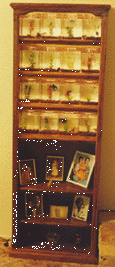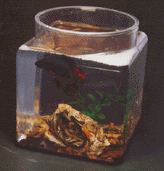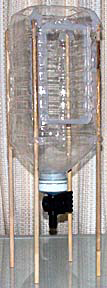

MY LIVING ROOM DISPLAY CASE
Because my living room is formally furnished, it was necessary to find some way to display the bettas that's in style with the rest of the room. The answer came in the form of an oak bookcase. The shelves come with under-hanging lips that hide a low profile lighting system. The jars are 3/4-gallon square plastic bottles, perfect for housing and displaying bettas.

The
book case is six feet tall
and
two feet wide.
I purchase my square bottles from CCW Distributors, Inc., 5861 Tennyson Street, Arvada, CO 80003, USA. Telephone 303-427-9663, URL http://www.ccwdist.com. I use the 95-ounce square jar, item number STQ, $22.50 for a case of sixteen... and that price includes the shipping and handling. They come with snap-on lids. I like the squat, square shape of these jars, which gives the fish the maximum amount of maneuvering space for a small tank. They are light weight and easy to clean.

Here's
a close up of one of the jars.
The
living volume measures 6.5 inches
on
each edge. This one holds Romeo, a
big
brute of a red veil tail. The plant,
gravel
and large rock take up room but
make
the tank much more decorative.
NEW!!! As much as I like these inexpensive jars, I got the idea that I might be able to develop a better one. The goal was to make a jar where wastes could be removed quickly without having to resort to a siphon. What came out of this was a prototype for what is undoubtedly the ugliest betta jar ever conceived.

The body is a flat sided 1 gallon Geyser water bottle turned upside down. I cut the base (now the top) off it and used aquarium sealant to glue a 1/2-inch irrigation valve to the cap, which is now at the bottom. Epoxy putty was used to create a smooth, tapered transition from the bottom of the shoulder of the water bottle to the valve's orifice to insure all wastes drifted unimpeded into the throat of the valve. More aquarium sealant was used to glue four support legs to the corners of the bottle.
The idea for this jar came from my preference of siphoning my betta tank several times during the day. This keeps the wastes from building up and fouling the water. The problem with this is that using the same siphon for all the tanks introduces the chance of disease being spread and that it takes ten to twenty minutes to do. Also, it's hard to get into all the nooks and crannies in a jar to collect all the waste. With this new jar all I have to do is open the valve for a fraction of a second and all the wastes and the worst of the fouled water, which collects in the lowest part of the tank, instantly drain away. If set in a row, a common drain line could be installed below the jars to catch the drained water and send it down a drain or to a collection bucket.
It took an hour to make this first prototype and cost $12.00, most of which was the price of the aquarium sealant.
In spite of the ribs moulded into the sides of the plastic jar, visibility is good enough so that I didn't really need to glue in a glass window to the front.
Besides it's obvious ugliness, the biggest disadvantages of this tank are it's large size, expense, and construction time.
I'll report the results in the future when I'm done testing it.
(Click
on Bettas to return to the main
betta page or on main site
to browse 70 topics ranging from exotic kaleidoscope designs to the
strange world of lucid dreaming.)